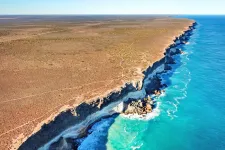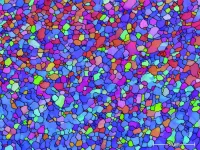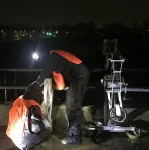(Press-News.org) Ocean-based hydrophones in the Comprehensive Nuclear-Test-Ban Treaty Organization (CTBTO)’s seismic-acoustic monitoring network could provide a better look at how ocean temperatures are changing over time, according to a presentation at the Seismological Society of America (SSA)’s 2023 Annual Meeting.
Finding new ways to monitor ocean temperatures is important for determining rates of warming, sea level rise and climate-related ocean circulation patterns as average global temperatures continue to rise, the researchers said.
Sound waves produced by earthquakes, called T waves, travel faster between their source and the hydrophones that detect them when the water in between the two points is warmer. As a result, researchers have been using T wave data to infer large-scale average ocean temperature changes, in a field called seismic ocean thermometry.
Land-based coastal stations sometimes have difficulty detecting these waves, which are created first in the solid earth by earthquakes and then converted to acoustic waves that travel through the water. To remedy this, Wenbo Wu of Woods Hole Oceanographic Institution and colleagues turned to CTBTO hydrophones to see if they could detect a clearer T wave signal.
Using two CTBTO hydrophones in the Indian Ocean, the researchers were able to capture T waves from earthquakes (magnitude 4 and smaller) that they then analyzed to track decadal warming and seasonal variations in ocean temperature, as well as detect energetic ocean circulation “swirls” called mesoscale eddies, Wu said.
Previous seismic ocean thermometry studies have relied on active source seismic signals—those produced by human-caused blasts or hammering to the ocean floor, he noted. “I think a major difference we are making here is that we are measuring natural earthquakes. And previously what scientists did was use active source.”
Hydrophones “are already used to monitor submarine earthquakes because they are very good at recording acoustic waves in the ocean,” Wu explained. But most land-based stations are not very good at recording T waves, “because these acoustic waves get decayed as they move into the continents.”
Hydrophones give the researchers a much better signal-to-noise ratio when it comes to detecting T waves from even small earthquakes, he said. “The data set from hydrophones is more than twice as large as from some land-based stations.”
With more T waves to analyze, researchers can better pinpoint the timing of ocean temperature changes, said Wu.
The technique could prove especially useful in regions where seismicity is naturally low, like the Atlantic Ocean, by boosting the overall number of useful earthquake sources, he suggested.
Wu and his colleagues also look at how T waves of different frequencies travel at different ocean depths. This phenomenon helps them monitor temperature changes over time within the water column, producing a “vertical slice tomography” look at temperature features within the ocean.
Wu said seismic ocean thermometry complements the other ways that scientists are tracking ocean temperature changes, including autonomous Argo floats and hydrographic surveys by ship. Each of these methods has its limitations—Most Argo floats measure temperatures only at shallow depths, for instance, and expensive surveys capture changes in only one part of the ocean for one specific time period.
The hydrophone-collected T wave data studied by Wu and colleagues could help expand the overall set of temperature changes collected across the oceans and offer a closer look at smaller, regional features as well.
END
Nuclear test ban treaty hydrophones help monitor ocean temperatures
2023-04-18
ELSE PRESS RELEASES FROM THIS DATE:
Surveys, focus groups reveal what Puerto Rico residents want to know after 2020-21 earthquakes
2023-04-18
In the wake of the 2020-2021 Southwest Puerto Rico earthquake sequence, researchers asked emergency responders and residents in affected communities about the information they needed to prepare for the next earthquake.
Residents surveyed door to door and in focus groups said they wanted to know more about and have easier access to an aftershock forecast, along with information on potential tsunami risk, according to a presentation at the SSA 2023 Annual Meeting.
Residents also wanted more information tailored specifically to their local area, said Jenniffer M. Santos-Hernández ...
Severe COVID-19 linked with 16-fold risk of life-threatening heart rhythm within 6 months
2023-04-18
Barcelona, Spain – 18 April 2023: Patients with severe COVID-19 requiring mechanical ventilation are 16 times more likely to develop ventricular tachycardia within six months compared to their peers without severe infection, according to research presented at EHRA 2023, a scientific congress of the European Society of Cardiology (ESC).1 Risks of other heart rhythm disorders were also elevated.
“The actual likelihood of developing ventricular tachycardia or other arrhythmias after severe COVID-19 is low for the individual ...
Stereotactic radiosurgery is effective for treatment of vestibular schwannomas in neurofibromatosis type 2
2023-04-18
April 18, 2023 –Vestibular schwannomas related to neurofibromatosis type 2 (NF2) are difficult to manage and are sometimes treated with a noninvasive option, stereotactic radiosurgery. A retrospective study conducted by an international, multicenter team found that stereotactic radiosurgery is effective for patients with these tumors while preserving serviceable hearing and not causing radiation-related tumor development or malignant transformation. These results are reported in the May issue of the Congress of ...
Global study first to compare COVID-19 vaccine hesitancy among college students
2023-04-18
As the world enters a post-pandemic phase, an international study is providing unique perspectives on COVID-19 vaccine hesitancies among college students.
Researchers from Florida Atlantic University, Ariel University in Israel, and the University of West Bohemia in Pilsen, Czech Republic, are the first to perform a cross-cultural comparison to investigate factors that influenced the decision to get the COVID-19 vaccine in an international sample of college students from the United States, Israel and the Czech Republic.
The study explored associations between vaccine hesitancy and ...
New research may hold key to better treatments for aggressive brain cancer
2023-04-18
Southfield, Mich., April 18, 2023 – For decades, researchers have marveled at the ability of glioblastoma, a particularly aggressive brain cancer, to turn off a patient’s cancer-fighting immune cells, thereby allowing tumors to grow freely. This remains a primary reason why there are very few effective therapies available for this mostly fatal disease.
In a new study using more than 100 patient-derived glioblastoma tumors, Prakash Chinnaiyan, M.D., a physician scientist in the Department of Radiation Oncology at Corewell Health in Southeast, Mich., along with colleague and lead author Pravin Kesarwani, Ph.D., ...
3D printing breakthroughs to accelerate ocular drug delivery, biodegradable contact lenses & pharma research
2023-04-18
WATERLOO, Ontario, April 18, 2023—Scientists from the Centre for Ocular Research & Education (CORE) are poised to unveil multiple advancements in 3D printing next week during the ARVO 2023 Annual Meeting in New Orleans. These innovations have widespread applications, with the potential to accelerate development of drug delivery systems, biodegradable contact lenses, and pharmaceuticals.
“Our multidisciplinary team has created one of the most sophisticated 3D printing environments for ocular research in the world,” said Alex Hui, OD, PhD, FAAO, head of Biosciences at CORE. “This ...
Nullarbor rocks reveal Australia’s transformation from lush to dust
2023-04-18
Curtin researchers have discovered how long ago the Australian Nullarbor plain dried out, with a new approach shedding light on how ancient climate change altered some of the driest regions of our planet.
Iron-rich layers formed in ancient sediments were used to narrow down when an area dried out in response to changes in climate, such as the dramatic decline of groundwater in southern Australia.
These ‘relics of drying’ suggest the Nullarbor drastically shifted to dry conditions between 2.4 and 2.7 million years ago, uncovering how these environmental changes were key in shaping Australia’s diverse ...
Recycled aluminum offers energy, emissions and electric vehicle battery range savings
2023-04-18
RICHLAND, Wash.—Scrap aluminum can now be collected and transformed directly into new vehicle parts using an innovative process being developed by the automotive industry, in particular for electric vehicles. Today, the Department of Energy’s Pacific Northwest National Laboratory, in collaboration with leading mobility technology company Magna, unveils a new manufacturing process that reduces more than 50% of the embodied energy and more than 90% of the carbon dioxide emissions by eliminating the need to mine and refine the same amount of raw aluminum ore. ...
Keys to women’s resilience after 80: more education, less stress
2023-04-18
COLUMBUS, Ohio – Having a four-year college degree and a low level of stress are strongly linked to psychological resilience in American women aged 80 and older, a new study suggests.
Researchers analyzed data from the Women’s Health Initiative to identify factors that are associated with higher self-rated resilience – the ability to weather storms and rebound from setbacks – among almost 30,000 women with an average age of 84.
Other characteristics linked to higher resilience included stronger social support, higher self-rated health and a lower risk of depression than levels among women ...
Not such small things: Microplastics in our streams
2023-04-18
UC Riverside scientists are taking a modern approach to studying a murky subject — the quantity, quality, and sources of microplastics in Los Angeles County’s urban streams.
Microplastics are particles with a maximum diameter of 5 millimeters, roughly the size of a pencil eraser. The category can include nanoplastics, which are far smaller than the width of an average human hair.
Scientists have been aware that these particles have been filtering through the environment for decades, but concern about them has only started to ramp up more recently.
“There is mounting evidence that these materials are toxic,” said Andrew Gray, UCR assistant professor of ...





